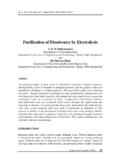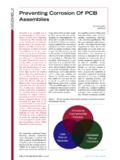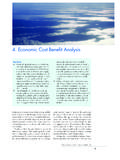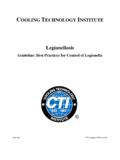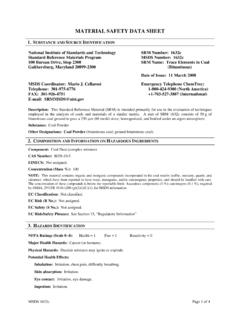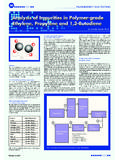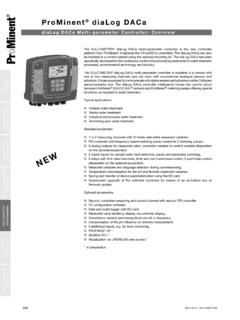Transcription of Critical for Clean- in-Place Systems Rosemount …
1 SPECIAL FOCUS: CIP/SIP. Measuring high concentrations of acid and caustic, as well as puri- Conductivity Measurement: ed rinse water, is necessary for CIP conductivity analysis. The process is becoming easier. Critical for clean - By Dave Anderson, Emerson Process Management, Rosemount Analytical in-Place Systems Liquid Division Clean- in-Place (CIP) technology , the automatic, contamination, and ultimately, provides p higher assurance reproducible and reliable delivery of cleaning solutions of product quality. and rinse water through process equipment and piping, However, achieving these benefits requires tight offers significant advantages to pharmaceutical and life measurement and control of the CIP process. A plant sciences manufacturing facilities. The ability to clean a manager must use the appropriate amounts of cleaning processing system incorporating tanks, pumps, valves, solutions and be able to determine reliably that those fi lters, heat exchange units and process piping without solutions have been removed completely before the next having to disassemble all or part of the system is a lower- processing run or campaign.
2 Conductivity analysis can cost, regulatory-compliant solution. Cleaning- in-Place help confirm those processes. Since the various cleaning also increases efficiency, improves safety, avoids cross- solutions are more conductive than the water used for 34 10/30/07 10:40:59 AM. SPECIAL FOCUS: CIP/SIP. flushing, conductivity measurement for cross-contamination. Each of the (as determined by FDA) is a function is a logical way to monitor the multiple stainless steel tanks holds a of detergent strength, cleaning time cleaning steps and the final rinse. different quality grade of water, such and temperature. This article will review the proper as deionized water (DI), hot or cold use of conductivity measurement in water for injection (WFI), and water WHERE CONDUCTIVITY WORKS. CIP Systems , and discuss advances in for reverse osmosis units (RO).
3 Conductivity measurement plays a conductivity analysis. The CIP process involves key role in the following CIP stages HOW CIP WORKS multiple cycles including an initial and functions: The key objectives of an efficient CIP and final drain step, a pre-rinse, CIP acid and caustic detergent system are: a sodium hydroxide wash and a concentration To provide Maximize safety to avoid post-rinse. Rinse and wash cycles detergent of the proper cross-contamination. vary from five minutes to one concentration for each CIP. Minimize CIP time to help hour. The process may include a circuit and to validate that speed time-to-market and reduce sanitize cycle to reduce the levels cleaning was done at the proper impact on plant production. of bacterial contamination using detergent strength, conductivity Optimize thermal efficiency strong oxidants such as hydrogen measurement is applied to the to avoid unnecessary heat loss peroxide, ozone, chlorine dioxide returning acid and caustic.
4 These and reduce energy requirements. or other chlorine-containing conductivity measurements are There are multiple configurations compounds. Thorough removal proportional to the concentration or of CIP Systems available, the of these chemicals is required to solution strength (see Figure 2, next two most common being single- prevent cross-contamination and to page) and are recorded by control use and multi-tank. In other avoid corrosion of the stainless steel Systems for validation. The fluids industries, multi-tank Systems are apparatus. are often partially neutralized typically used to provide for the When the CIP process is initiated, during the CIP process, and recycling of water and possible pre-rinse water is sent through the additional concentrate dosing is regeneration of cleaning chemicals. circuit and chases the product.
5 A required. Conductivity indicates There is, however, a greater risk timing sequence based on distances when sufficient concentrate has of cross-contamination with this and flow rates will switch the valves been added to the appropriate configuration. Pharmaceutical and at the proper time to minimize the tanks. Figure 1 (below) shows a life sciences manufacturers typically interface between product and rinse typical configuration. employ multi-tank Systems , but use water. Over 90% of the product CIP/process interface and CIP. them as single-use Systems , with residue is removed during pre-rinse completion . the tanks being drained between in order to minimize the use of Because the various cleaning programs to minimize the potential washing chemicals. Proper cleaning solutions are more conductive TT. Fresh water CIP return Acid Caustic concentrate concentrate CT CT.
6 LT LT LT LT. TT PT. DT FT FT. CIP. supply Steam Figure 1: CIP equipment/process configuration. 35 10/30/07 10:41:06 AM. SPECIAL FOCUS: CIP/SIP. 900,000. solution can foul or corrode the electrodes. Inductive 800,000. sensors are non-contacting and are often called toroidal because they use toroidal transformers isolated from the process. One toroid acts as a transmitter and the other 700,000 as a receiver. The transmitter toroid produces an electric current in the process solution that induces a voltage in Microsiemens At 25 C. 600,000 the receiver toroid. The strength of that induced voltage is directly proportional to the conductivity of the solution. Nitric Acid Inductive sensors (traditionally used to measure the 500,000 Sulfuric Acid Hydrochloric Acid caustics and acids in the CIP process) also come in two Potassium Chloride Sodium Chloride types.
7 Standard inductive sensors have a donut shape Sodium Hydroxide 400,000 and are inserted into the pipe where the measured solution flows around and through them. This type of 300,000 sensor is frequently used in applications with line sizes greater than two inches, as the sensor does not impede flow. For applications with line sizes of two inches or 200,000. less, an inductive flow-through sensor may be ideal. In this configuration, the sensor is not inserted in the pipe, 100,000 but is clamped into the process piping between flanges. Because the sensor is virtually a part of the pipe, it does not impede flow. 0 5 10 15 20 25 30 35 40 45 50 55 60. However, these traditional rules regarding sensor % By Weight selection are changing, due to one of the most important issues in CIP conductivity measurement dynamic range.
8 Figure 2: Concentration vs. conductance of NAOH (sodium hydroxide). and other chemicals. EXPANDING DYNAMIC RANGE AND. than the water used for flushing and final rinsing, NOISE PERFORMANCE. conductivity measurement is a cost-effective way A significant challenge in CIP conductivity analysis is to monitor the CIP steps. It is highly effective at that the process involves two distinctly different conduc- detecting the interface between cleaning solutions and tivity measurement ranges one for moderate-to-high the product so that the valves can be switched at the concentrations of acid and caustic, and the other for the appropriate time to minimize the interface between purified rinse water. Therefore, the process has tradition- the two and any resulting product loss. Conductivity ally required two conductivity sensors one with a measurement can also determine the interface between high cell constant required to measure >100mS/cm, cleaning fluids and rinse water to minimize CIP and one with a low cell constant equipped to measure time while meeting compliance requirements.
9 When the <10 S/cm of ultrapure water. the conductivity drops to the value of rinse water, it Typically, the caustic is measured with an inductive indicates that the water is running clear, prompting the conductivity sensor or four-electrode contacting next step or the end of the cycle. conductivity sensor, while the purified rinse water is measured with a two-electrode contacting conductivity SELECTING THE RIGHT CONDUCTIVITY SENSOR sensor. Since two-electrode contacting conductivity Conductivity sensors used in CIP applications must be of sensors become non-linear on the high end of the sanitary design. This means the sensor surface should not conductivity range, and inductive or four-electrode have contours or crevices that could trap residue from the conductivity sensors do not measure accurately at the product and cause decay or harbor microorganisms that low end of the conductivity range, traditionally, two would result in cross-contamination.
10 They also must be sensors have been required for the application. In fact, made of FDA-approved materials. some applications have simply measured the cleaning There are two main types of sanitary conductivity solutions and ignored the rinse water due to the added sensors contacting and inductive. Contacting sensors cost and complexity of using a totally different type of bring the measurement electrodes into contact with the sensor and an additional analyzer. solution to be measured. This can be a problem if the However, new technology has made it easier for 36 10/30/07 10:41:09 AM. SPECIAL FOCUS: CIP/SIP. the plant manager wanting to implement a CIP system without excessive cost and complexity. First, dual sensors with a single, multi-channel analyzer having multi-ranging measurement capabilities are available.










